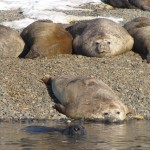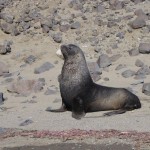Wildlife at Rothera

Rothera sees a wide variety of wildlife throughout the year. All of the large animals around Rothera rely on the ocean and particularly on krill as a basis for their diet; there is very little that grows on land.
Seals, penguins and whales form the majority of the wildlife seen at Rothera during the short summer season. During the winter, Rothera is ice-bound with very little wildlife.
Marine Biologist Belinda Vause is an expert in marine animals and from her boat, the Nimrod, is perfectly placed to watch it. She has shared some of her pictures and knowledge for this blog.
See more pictures of wildlife around Antarctica here.
Seals
Leopard seals

Leopard seals are the most predatory of the seals at Rothera, and will take penguins, small seals (particularly young crabeaters), fish and krill. They are known to shake their prey so vigorously, they can turn it inside out!
There is little evidence that leopard seals will attack people, but there has been one horrendous accident. They have, however, been known to puncture boats and are often quite curious. They will come and take a look at anything sitting at the water’s edge. They are seen on a weekly basis at Rothera, where they are a nuisance to divers, as they cannot dive if leopard seals are in the vicinity.
Leopard seals have distinctive spots, which gives them their name. In profile, they have long fins, a snakelike appearance, big and powerful shoulders, and a smiling face. They are solitary and hunt and rest on icebergs alone.
They often hang around haul-out sites to catch penguins and seals. Bel has seen them resting on icebergs after a dive, but has never seen them during a dive. Leopard seals can be up to 2.8 m in length and weigh up to 325 kg, with the females slightly larger.
Elephant seals

Elephant seals cluster around Rothera in vast numbers. They don’t breed around here, and most are adolescents. The larger males frequently fight, practising for when they will control their own harem.
The elephant seal is the largest seal in the world today, and, unusually for seals, the bulls are much larger than the females. Their burping and farting sounds from their growls and fights carry a long distance, and they can be frequently heard (and smelled) all around The Point. They haul out and rest onshore for weeks at a time, and recently, a few colonised the main road at Rothera.
The name Elephant Seal comes from the distinctive nose on the bulls. This proboscis is inflatable and is used as a symbol of their status during fighting.
Elephant seals can dive up to 1000m deep and for up to 30 minutes, hunting for squid and fish in the deeps. They can be up to 4.5 m in length (females 2.8 m) and weigh up to 4000 kg (that’s four tonnes!) for the bulls and 900 kg for the females.
Crabeater seals

Crabeater seals, despite their name, do not eat crabs. Instead, they eat krill and crustaceans, but they have distinctive teeth that they use to filter sea water with krill in. They are then able to retain and swallow their catch.
Crabeaters are the most abundant seal in the world, and are often scarred from conflicts with the leopard seals. At Rothera, they are often seen lying on the floes, either alone or in small groups.
Crabeaters can be up to 2.6 m in length and weigh up to 225 kg, with the females being slightly larger.
Weddell seals
Weddell Seals also colonise the shores and floes around Rothera. They are usually alone and have distinctive puppy-dog eyes. They are the most southerly mammal, living at up to 78°S and almost exclusively in fast pack ice. They can stay underwater for over an hour and dive up to 750 m, where they hunt Antarctic cod, crustaceans and squid. They can swim several kilometres under the ice without needing a breathing hole.
They enlarge the breathing holes with their teeth, and when their teeth are eroded they cannot hunt or breathe. Because of this they have shorter lives, living up to about 22 years (compared with up to 40 years for the other seal species). A Weddell was the first seal that Bel saw, and they are very common Around The Point. Bel has also heard their singing when diving underwater.
Weddell Seals are around 3 m in length and weigh up to 450 kg.
Fur seals
Fur Seals are known around Rothera but have not been seen this season yet. They usually arrive around the end of January.
Whales
Orcas

Whales often visit the waters around Rothera, where they hunt krill, seals or penguins. Killer Whales, or Orcas, are actually a species of dolphin. Their latin name, Orcinus orca, bring Bringer of death, Sea Monster.
The largest of the dolphins, they grow up to 9 m and can weigh up to 7 tonnes. Bel has seen Orcas whilst out on the boat, and must watch them before diving. They have been known to spyhop around the RIBS used for diving, and are frequently curious. Divers are not allowed in the water if orcas have been seen.
Spyhopping

Orcas hunt in groups, led by a matriarch, a dominant female. They catch seals, penguins and, on occasion, other whales. However, there are no records of them taking scientists yet, although they can tip in ice floes in order to tip in unwary seals. They have distinctive dorsal fins, which makes identification easy.
Humpback whales

Humpbacks are sometimes seen around Rothera, and the ships sailing across the Southern Ocean often see them. At the time of writing, they are following the RRS James Clark Ross.
Humpbacks can be up to 15 m in length and weigh up to 48 tonnes. They eat krill, crustaceans and plankton, which they sieve out from the sea water.
Birds
Penguins

The penguin most commonly seen around Rothera is the Adélie Penguin. The Adélie breeds further south than any other penguin. They often come and inspect the base, pausing to look at the vehicles or making a nuisance of themselves on the runway. They are often seen on ice floes or onshore around Rothera and the Islands, where their funny gait and amusing antics keep everyone interested for hours.
They are often seen tobogganing around on their stomachs, and can porpoise when they are swimming. They don’t breed at Rothera, but are frequent visitors. They are the most abundant of all penguins, but their populations are declining, probably as a result of long-term climate change.
Bel’s closest experience with a penguin is when one particularly curious animal jumped onto the boat and came for a ride! It stayed with the boat for about five minutes, just to see what was going on.
Skua
Skuas are the gulls of the Antarctic. They are scavengers and opportunistic feeders, and will take sea fish, krill, penguin eggs, chicks and carrion. Skuas nest on the bare ground and will attack anyone who comes too close!
It is wise to keep your hands high or even better, to have a pole to raise high, as they will dive bomb the highest part.
Antarctic Shag (Blue eyed shag)

The Antarctic Shag (or Blue-Eyed Shag) is cormorant that feeds on crustaceans, krill, squid, fish and invertebrates.
It is commonly seen on the shores and ice around Rothera. They dive into the water to chase their prey. They are most commonly seen nesting on Shag Rock, near to Rothera station.





















so handy!!!!!